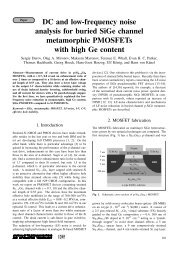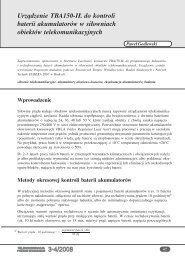The Kummer confluent hypergeometric function and some of its ...
The Kummer confluent hypergeometric function and some of its ...
The Kummer confluent hypergeometric function and some of its ...
Create successful ePaper yourself
Turn your PDF publications into a flip-book with our unique Google optimized e-Paper software.
<strong>The</strong> <strong>Kummer</strong> <strong>confluent</strong> <strong>hypergeometric</strong> <strong>function</strong> <strong>and</strong> <strong>some</strong> <strong>of</strong> <strong>its</strong> applications in the theory <strong>of</strong> azimuthally magnetized circular ferrite waveguides<br />
the second <strong>Kummer</strong> theorem [1–4, 7, 9, 10, 13, 16]. Values<br />
<strong>of</strong> ζ (c)<br />
k,n for small <strong>and</strong> large |k| are listed in Tables 1<br />
(c)<br />
<strong>and</strong> 2. <strong>The</strong> analysis shows that it is true: lim ζ<br />
k→−∞<br />
k,n = 0<br />
<strong>and</strong> lim<br />
k→+∞<br />
(c)<br />
(c)<br />
ζ k,n = +∞. <strong>The</strong> products |k|ζ k,n<br />
<strong>and</strong> |a|ζ (c)<br />
k,n are<br />
<strong>of</strong> special interest, if k gets very large negative (see Table<br />
2). It is valid [72]:<br />
Lemma 5: If ζ (c)<br />
k,n is the nth positive purely imaginary zero<br />
<strong>of</strong> <strong>Kummer</strong> <strong>function</strong> Φ(a, c; x) in x (n = 1, 2, 3...) provided<br />
a = c/2 − jk – complex, c = 2Rea – restricted positive<br />
integer, x = jz – positive purely imaginary, z – real,<br />
positive, k = j(a − c/2) – real, then the infinite sequences<br />
<strong>of</strong> positive real numbers {ζ (c) (c) (c)<br />
k,n }, {|k|ζ k,n } <strong>and</strong> {|a|ζ k,n } are<br />
convergent for k → −∞ (c, n – fixed). <strong>The</strong> limit <strong>of</strong> the<br />
first sequence is zero <strong>and</strong> the limit <strong>of</strong> the second <strong>and</strong> third<br />
ones is the same. It equals the finite positive real number L,<br />
where L = L(c, n). It holds:<br />
(c)<br />
lim |k|ζ<br />
k→−∞<br />
k,n = L(c, n), (7)<br />
(c)<br />
lim |a|ζ<br />
k→−∞<br />
k,n = L(c, n). (8)<br />
For any |k| <strong>and</strong> relevant |a| it is true |k|ζ (c)<br />
k,n < L(c, n) <<br />
|a|ζ (c)<br />
(c) (c)<br />
(c)<br />
k,n . In case k → +∞, {ζ k,n }, {|k|ζ k,n }, <strong>and</strong> {|a|ζ k,n }<br />
also tend to +∞. Results for complex Φ – <strong>function</strong> can be<br />
found in [55, 57–59, 72], too.<br />
6. Some properties <strong>of</strong> the real<br />
<strong>Kummer</strong> <strong>function</strong><br />
6.1. Properties due to the analytical study<br />
by F. G. Tricomi<br />
Tricomi has proved that if â, ĉ, ˆx are real, ˆx > 0 <strong>and</strong> ĉ > 0:<br />
– the <strong>Kummer</strong> CHF Φ(â, ĉ, ˆx) has real positive zeros<br />
only if â < 0;<br />
– the number <strong>of</strong> zeros ˆl = abs[â] is finite, [â] is the<br />
largest integer less or equal to â, i.e., [â] ≤ â;<br />
– at the point â = [â] = − ˆn ( ˆn ≤ ˆl – a positive integer,<br />
ˆn = 1, 2, ..., ˆl) a new zero appears [1–3, 7, 9, 10, 44].<br />
6.2. Properties due to the numerical study<br />
<strong>The</strong> case â = ĉ/2+ ˆk – real, ĉ – positive integer, ˆk – real<br />
(ˆk = â−ĉ/2), ˆx – real, positive, is treated. Computations <strong>of</strong><br />
the <strong>function</strong> Φ(1.5+ ˆk, 3; ˆx) have been performed, making<br />
use <strong>of</strong> series (1). Figures 5 <strong>and</strong> 6 represent Φ versus ˆx for<br />
ˆk > 0 (solid lines), ˆk = 0 (dotted curve) <strong>and</strong> ˆk < 0 (dashed<br />
lines). <strong>The</strong> monotonous (oscillating) character <strong>of</strong> curves<br />
for ˆk > −1.5 (ˆk < −1.5) is in agreement with above analytical<br />
results. Values <strong>of</strong> the real zeros ˆ ζ (ĉ)<br />
ˆk,<br />
<strong>of</strong> the same <strong>function</strong><br />
ˆn<br />
are given in Tables 3–5 for different intervals <strong>of</strong> variation<br />
<strong>of</strong> ˆk. <strong>The</strong> distribution <strong>of</strong> the first eight zeros <strong>of</strong> Φ against<br />
ˆk is drawn in Fig. 7. <strong>The</strong> numerical analysis indicates<br />
Fig. 5. <strong>Kummer</strong> <strong>function</strong> Φ(1.5 + ˆk, 3; ˆx) against ˆx for ˆk =<br />
−1.5(0.5)3.<br />
Fig. 6. <strong>Kummer</strong> <strong>function</strong> Φ(1.5 + ˆk, 3; ˆx) versus ˆx for ˆk =<br />
−5(0.5) − 1.5.<br />
ˆζ (ĉ)<br />
ˆk,<br />
= +∞.<br />
ˆn<br />
that it holds: lim ˆζ<br />
ˆk→−∞<br />
(ĉ)<br />
ˆk,<br />
= 0 <strong>and</strong> lim<br />
ˆn ˆk → −( ˆn − 1) − ĉ/2<br />
ˆk < −( ˆn − 1) − ĉ/2<br />
<strong>The</strong> products |ˆk| ˆ ζ (ĉ)<br />
ˆk, ˆn <strong>and</strong> |â| ˆ ζ (ĉ)<br />
ˆk, ˆn are <strong>of</strong> interest, if ˆk is very<br />
large negative (Table 5). It is true:<br />
Lemma 6: If ζ ˆ(ĉ) ˆk,<br />
is the ˆnth positive real zero <strong>of</strong><br />
ˆn<br />
<strong>Kummer</strong> <strong>function</strong> Φ(â, ĉ; ˆx) in ˆx ( ˆn = 1, 2, ..., ˆl, ˆl =<br />
abs[â]) provided â, ĉ, ˆx are real, ĉ – restricted positive<br />
integer <strong>and</strong> ˆk = â − ĉ/2 – real (â = ĉ/2 + ˆk), then<br />
119





